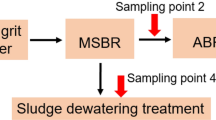Abstract
We explored the microplastic (MPs) emissions of Japanese municipal solid waste incinerators (MSWIs); specifically, the numbers and types of MPs in wastewaters discharged by three MSWIs. We calculated the MSWI MPs emission factors and inventories, and we discuss the results. More than fifteen types of MPs, principally fragments shape were detected. It was important to obtain composite samples because the nature of raw wastewater fluctuated significantly during both day and night in response to the MSWI treatments. MSWI wastewater treatments tended to remove larger particles; over 99% of MPs (in terms of both number and weight) were ultimately removed. The MP emission inventory from MSWIs to public water bodies was 7.22 × 105–1.64 × 106 MPs/year for MPs sized 100–5000 µm. This is very low, at only 0.0053–0.026% of the total MP emission inventory Japanese WWTPs. It is, therefore, possible to remove almost 100% plastics in input waste via incineration and wastewater treatment.










Similar content being viewed by others
References
World Economic Forum (2016) The new plastics economy: rethinking the future of plastics, pp 14. https://jp.weforum.org/reports/the-new-plastics-economy-rethinking-the-future-of-plastics. Accessed 4 Apr 2023
Kailash PP, Ujjwal RJ, Jeetesh K, Madhumita P, Siddharth UM, Abhishek SD (2023) Practical ways to recycle plastic: current status and future aspects. J Mater Cycles Waste Manag 25:1249–1266
Rashid ME, Khan MR, Haque RU, Hasanuzzaman Md (2023) Challenges of textile waste composite products and its prospects of recycling. J Mater Cycles Waste Manag 25:1267–1287
Yang Z, Lü F, Zhang H, Wang W, Shao L, Ye J, He P (2021) Is incineration the terminator of plastics and microplastics? J Hazard Mater 401:123429
Tanaka S, Kakita M, Yukioka S, Suzuki Y, Fujii S, Takada H (2019) Behavior of microplastics in wastewater treatment and estimation of its loading to lake Biwa. J Jpn Soc f Civ Eng Ser G (Environmental Research) 75(7):I35-40
Nakao S, Akita K, Masumoto K, Ozaki A, Okuda T (2020) Behavioral Analysis of microplastics entering sewage treatment plants (Report 2), In: Proceeding of the 57th Annual Technical Conference on Sewerage, pp 454–456
Kawai T, Oshita K, Kusakabe T, Oleszek S, Tanaka S, Takaoka M, Fujiwara T (2021) Emission behaviors of Microplastics in Wastewater from a Municipal Solid Waste Treatment Plant and Landfill Sites. EICA 26(2–3):68–80 (in Japanese)
Harada H, Takaoka M, Oshita K, Kondo M, Teshima K, Morita K, Tani N, Hirosawa Y, Tanid, K, Kinoshita R, Nama M, Fujinaga Y, Sugimura E, Furukawa W, Kamon H, Endo M, Takeshita T (2021), Survey of microplastic emissions from waste treatment facilities. In: Proceeding of the 32nd Annual Conference of Japan Society of Material Cycles and Waste Management, pp 5–6 (2021) (in Japanese)
APHA (1992) Standard methods for the examination of water and wastewater, 18th edn. American Public Health Association, Washington DC
He P, Chen L, Shao L, Zhang H, Lü F (2019) Municipal solid waste (MSW) landfill: a source of microplastics?—Evidence of microplastics in landfill leachate. Water Res 159:38–45
Su Y, Zhang Z, Wu D, Zhan L, Shi H, Xie B (2019) Occurrence of microplastics in landfill systems and their fate with landfill age. Water Res 164:114968
Japan Society of Waste Management Experts (1997) Handbook of solid waste management, Japan, Ohmsha, pp 387–465. https://www.ohmsha.co.jp/book/9784274023248/ (in Japanese)
Research and statistics department minister’s Secretariat Ministry of Economy, Trade and Industry (METI), Yearbook of current production statistics chemical industry in 2021 (2022). https://www.meti.go.jp/statistics/tyo/seidou/result/ichiran/08_seidou.html (in Japanese). Accessed 4 Apr 2023
Simon M, van Alst N, Vollertsen J (2018) Quantification of microplastic mass and removal rates at wastewater treatment plants applying Focal Plane Array (FPA)-based Fourier Transform Infrared (FT-IR) imaging. Water Res 142:1–9
Waste Management Division, Environmental Regeneration, and Material Cycles Bureau, Ministry of Environment, Japan, Waste Management Technical Information, Japan, Results of Survey on General Waste Disposal (2023) (in Japanese) https://www.env.go.jp/recycle/waste_tech/ippan/index.html. Accessed 4 Apr 2023
ECHA Guidance on information requirements and chemical safety assessment Chapter R.18: Exposure scenario building and environmental release estimation for the waste life stage. p. 50 (2012). https://echa.europa.eu/documents/10162/17224/r18_v2_final_en.pdf/e2d1b339-f7ca-4dba-8bdc-76e25b1c668c?t=1351092123467. Accessed 4 May 2023
Tanaka Y (1979) Review of the methods of quantification. Environ Health Perspect 32:113–123
Takeda N, Takaoka M, Oshita K, Eguchi S (2013) PCDD/DF and co-planar PCB emissions from crematories in Japan. Chemosphere 98:91–98
Isobe A, Buenaventura NT, Chastain S, Chavanich S, Cózar A, DeLorenzo M, Hagmann P, Hinata H, Kozlovskii N, Lusher AL, Martí E, Michida Y, Mu J, Ohno M, Potter G, Ross PS, Sagawa N, Shim WJ, Song YK, Zhang W (2019) An interlaboratory comparison exercise for the determination of microplastics in standard sample bottles. Mar Pollut Bull 146:831–837
Japan sewerage works association: Japan sewerage statistics (2020) (in Japanese)
Acknowledgements
This research was performed by the Environment Research and Technology Development Fund (JPMEERF21S11930) of the Environmental Restoration and Conservation Agency Provided by the Ministry of Environment of Japan. We thank Prof. Taku Fujiwara and Shuhei Tanaka, Kyoto University Japan, who supported us in the analytical process.
Author information
Authors and Affiliations
Corresponding author
Additional information
Publisher's Note
Springer Nature remains neutral with regard to jurisdictional claims in published maps and institutional affiliations.
Supplementary Information
Below is the link to the electronic supplementary material.
Rights and permissions
Springer Nature or its licensor (e.g. a society or other partner) holds exclusive rights to this article under a publishing agreement with the author(s) or other rightsholder(s); author self-archiving of the accepted manuscript version of this article is solely governed by the terms of such publishing agreement and applicable law.
About this article
Cite this article
Tsunematsu, M., Oshita, K., Kawai, T. et al. Behaviors and emission inventories of microplastics from various municipal solid waste incinerators in Japan. J Mater Cycles Waste Manag 26, 692–707 (2024). https://doi.org/10.1007/s10163-023-01804-7
Received:
Accepted:
Published:
Issue Date:
DOI: https://doi.org/10.1007/s10163-023-01804-7




